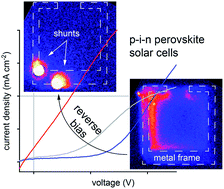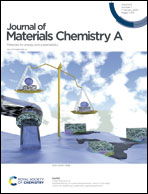Instability of p–i–n perovskite solar cells under reverse bias†
Abstract
Partial shading can trigger permanent damage in photovoltaic modules because the illuminated solar cells drive the shaded cells into reverse bias. Under reverse bias conditions, perovskite solar cells have been shown to degrade quickly due to processes that have so far remained elusive. Here, we combine optical, microstructural, and electrical characterization to address the mechanisms governing perovskite solar cell degradation under reverse bias. Three main processes are shown to occur in cesium/formamidinium lead iodide/bromide cells depending on the reverse voltage applied, the duration of the reverse bias treatment and the cell structure. The first and most severe involves the formation of highly conductive shunts, preferentially in regions covered by the metal electrode (with apparently equal propensity for various metals) and, at higher reverse voltages, within the perovskite active area. Second, we find that iodide is reversibly driven into the organic electron transport layer, causing an S-shape in the current–voltage curve and lowering power conversion efficiency. Finally, under heavy reverse biasing the perovskite absorber is shown to degrade into iodide- and bromide-rich sub-layers, an irreversible process associated with a shift in the effective band gap and changes to the perovskite microstructure. Criteria that must be met to pass partial shading tests defined by the International Electrotechnical Commission are also discussed in relation to these issues, indicating the urgent need for device structures far more robust than those usually reported.



 Please wait while we load your content...
Please wait while we load your content...